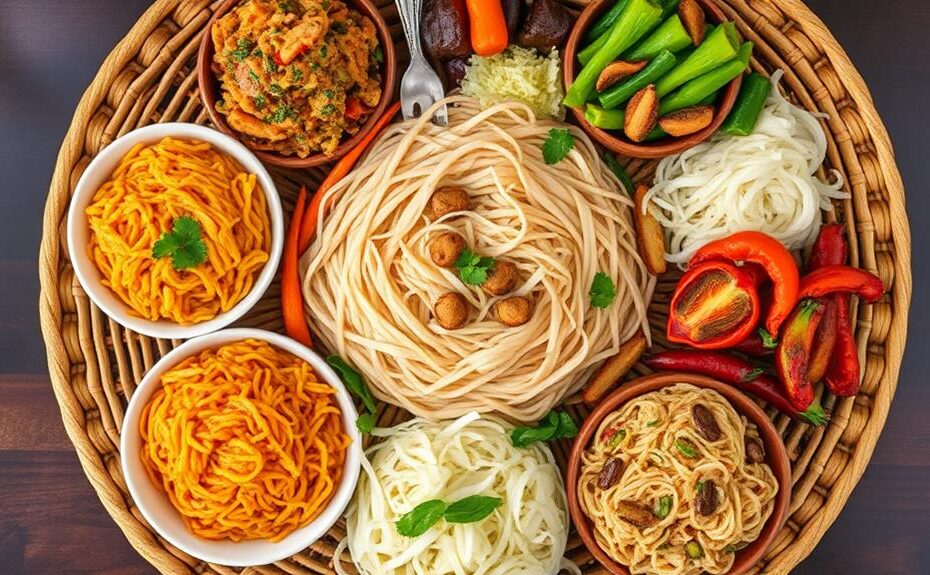The Philippines boasts over 20 unique types of pancit, each with its own cultural significance and cooking methods.
These varieties can be broadly classified into two categories: traditional noodle types and regional variations.
Noodle types include Pancit Bihon, Canton, Lomi, and Misua, each with its distinct texture and ingredients. For instance, Pancit Bihon is made from rice flour noodles, while Canton is made from wheat flour noodles.
Regional variations showcase local tastes and ingredients. Examples include Pancit Malabon, Bam-I, and Abra, each with its unique flavor profile. Pancit Malabon, for instance, is known for its sweet and savory sauce.
Innovative non-noodle pancit variants also exist, utilizing alternative ingredients. Examples of these include Pancit Buko, Estacion, and Molo. Pancit Buko, for instance, uses young coconut strips instead of traditional noodles.
Types of Pancit Noodles
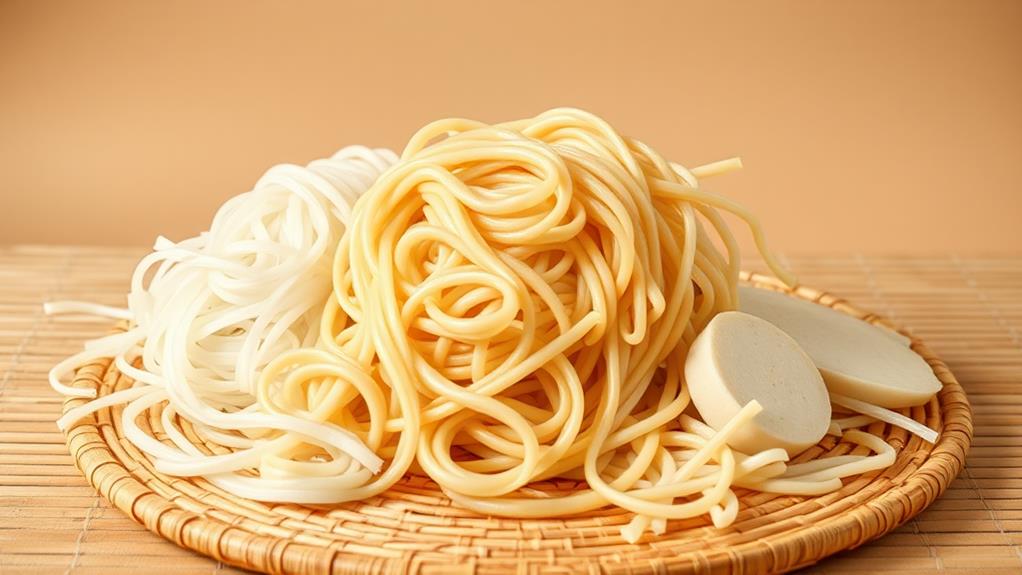
Pancit Noodles: A Staple in Filipino Cuisine
Characteristics of Pancit Noodles
Pancit noodles are a fundamental component of Filipino cuisine, with each type boasting unique characteristics. Understanding these differences is essential to creating authentic pancit dishes.
Pancit Bihon: Thin Rice Noodles
Pancit Bihon consists of thin rice noodles made from cornstarch and rice flour. These noodles are ideal for stir-fries and soups due to their ability to absorb flavors from sauces and broths.
Pancit Canton: Egg-Based Noodles
Pancit Canton features egg-based, wheat flour noodles similar in texture to spaghetti but flimsier. Their durability makes them perfect for stir-fried dishes.
Other Types of Pancit Noodles
Other notable types of pancit noodles include:
- Pancit Lomi: characterized by its wide, thick yellow egg noodles that provide a hearty texture.
- Pancit Miki: consisting of egg noodles made from all-purpose flour, available in flat or round shapes.
- Pancit Misua: referring to extremely thin salted noodles made from wheat flour, primarily served in soups and known for their quick cooking time.
Each type of pancit noodle offers a distinct texture and flavor profile, allowing for a wide range of culinary possibilities in Filipino cuisine.
Regional Variations of Pancit
Across the Philippines, regional variations of pancit have evolved, reflecting local tastes and ingredient availability.
Regional Variations of Pancit
Each region in the Philippines has its own unique take on pancit dishes, often shaped by the ingredients readily available in the area.
Pancit Malabon from Malabon City features thick rice noodles topped with seafood and a rich shrimp paste sauce, making it a festive favorite.
Pancit Bam-I, originating from Cebu, combines both Bihon and Canton noodles, stir-fried with a mix of meats and vegetables for a unique taste.
Pancit Abra, a variant of Pancit Miki popular in Northern Luzon, is known for its thick egg noodles and savory flavor profile.
These regional variations showcase the diversity of pancit dishes across the Philippines.
Cooking Methods and Ingredients
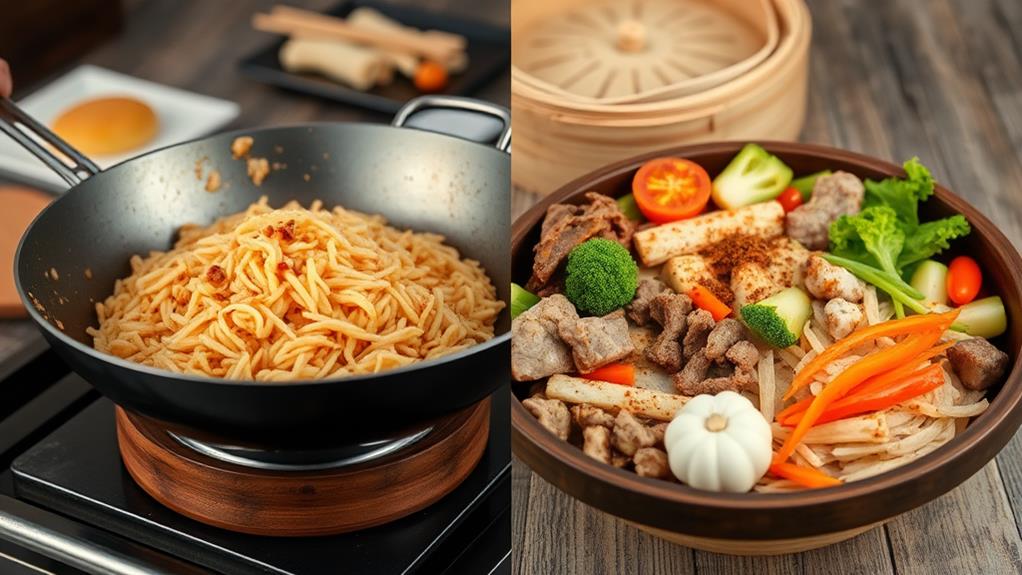
Pancit dishes can be prepared using various cooking methods, depending on the type of noodle and the desired outcome. Stir-frying, boiling, and braising are common cooking methods used to create different textures and flavors.
For instance, stir-frying is ideal for bihon noodles, while boiling is better suited for Canton noodles.
The choice of noodle plays a significant role in pancit preparation. Bihon (rice vermicelli), Canton (egg noodles), and miki (thick egg noodles) are popular options, each requiring specific cooking techniques.
Pancit ingredients include a variety of meats and vegetables. Meats like chicken, pork, and seafood are commonly used, along with vegetables such as carrots, cabbage, and bell peppers to add flavor and nutritional value.
Soy sauce, oyster sauce, and calamansi juice are essential seasonings that enhance the taste of pancit, while garlic and onions provide aromatic depth.
The broth or sauce used in pancit can vary widely. Rich, savory sauces and lighter broths are both options, showcasing the versatility of the dish.
Non-Noodle Pancit Variants
Filipino cuisine's resourcefulness is showcased through creative pancit variations that go beyond traditional noodles.
Some pancit variants have abandoned noodles altogether, using innovative ingredients to create unique textures and flavors. Pancit Buko is a notable example, substituting long strips of young coconut meat for noodles, resulting in a light and refreshing dish.
Regional variations have also emerged, offering distinct flavors and textures. Pancit Estacion, originating from Tanza, Cavite, features mung bean sprouts as a noodle alternative, providing a distinct texture and flavor profile.
Another example is Pancit Molo, a wonton soup variant where wonton wrappers serve as the noodle component, creating a hearty and flavorful broth experience.
Filipino cuisine's adaptability is demonstrated through the use of local ingredients in innovative ways. Pancit Kilawin uses shredded unripe papaya, while Pancit Labong incorporates julienned bamboo shoots, showcasing the versatility of pancit dishes.
Cultural Significance of Pancit

Pancit holds profound cultural significance in Filipino tradition.
This significance extends beyond its culinary appeal, symbolizing long life and good fortune. In Filipino culture, pancit is often served during celebrations and special occasions like birthdays to convey wishes for longevity.
Traditionally, pancit dishes are prepared in large quantities for communal sharing. This emphasizes the Filipino value of togetherness and family during gatherings.
The preparation and consumption of pancit during significant events highlight its role as a cultural marker, reinforcing social bonds and familial ties within Filipino communities.
Each region in the Philippines has its own unique variations of pancit. These variations showcase local ingredients and cooking styles, further emphasizing the diversity and cultural richness of the Filipino culinary heritage.
Through pancit, you'll experience the fusion of Chinese and Filipino influences, reflecting the country's cultural adaptability and creativity.
History of Pancit Noodles
Chinese merchants introduced pancit noodles to the Philippines in the 16th century, marking the beginning of a culinary fusion that would forever change the country's gastronomic landscape. This merging of Chinese culinary traditions with local ingredients and customs laid the foundation for a unique Filipino dish. The term "pancit" is derived from the Hokkien language, with meanings related to noodles and convenient food, reflecting its origins in Chinese cuisine.
Pancit evolved from a working-class meal to a beloved dish enjoyed across all social classes. Over time, it became a staple at celebrations and gatherings. For instance, in the Philippines, pancit is often served during birthdays, weddings, and other significant life events.
The adaptation of pancit in the Philippines demonstrates the influence of various cultures. This led to unique regional variations that incorporate local flavors and ingredients. For example, in the province of Pampanga, pancit is made with a variety of vegetables and served with a sweet sauce, while in the Visayas region, it's cooked with seafood and spices.
Pancit is associated with long life and good fortune in Filipino culture. This significance is highlighted by its presence at birthdays and other significant life events.
Today, pancit remains an integral part of Filipino culinary traditions, with its rich history and cultural significance continuing to inspire new generations of cooks and food enthusiasts.
Pancit in Filipino Cuisine
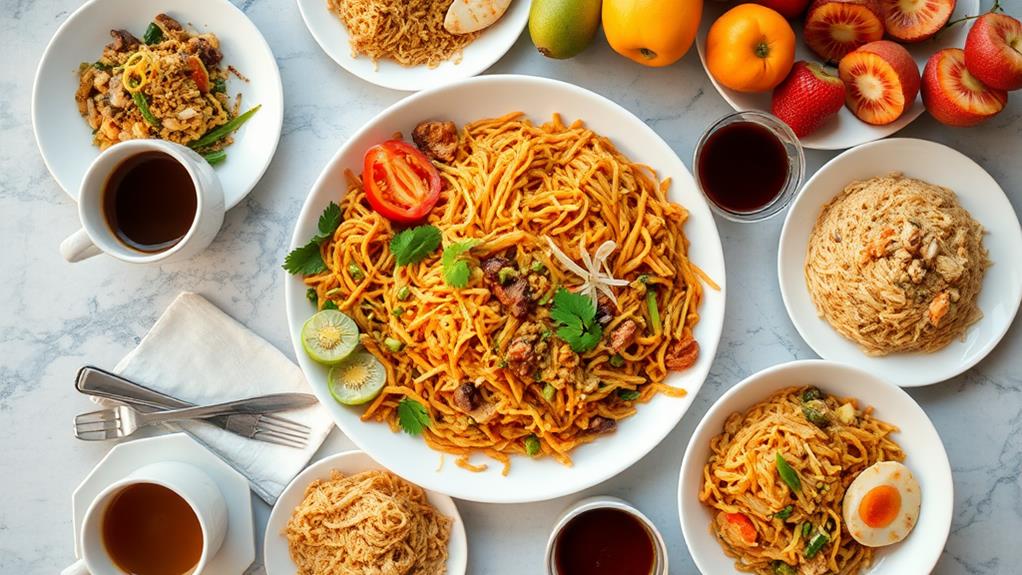
Pancit is a culinary icon in Filipino cuisine, reflecting the country's cultural heritage. This dish is characterized by a diverse array of noodle dishes, with various types of noodles like Bihon, Canton, and Lomi, each having unique textures and preparation methods.
Local ingredients are expertly combined to create flavor profiles that are quintessentially Filipino. These ingredients include vegetables, meats, and seasonings like soy sauce, oyster sauce, and calamansi. The combination of these ingredients results in a rich culinary experience.
Pancit is often served during celebrations, symbolizing long life and good fortune in Filipino culture. With over 20 distinct varieties across the Philippines, each region showcases its own adaptations of pancit, highlighting the country's rich culinary diversity.
Different regions have their own unique pancit adaptations, offering a wide range of flavors and textures. For example, Lomi from Batangas is known for its thick, chewy noodles, while Pancit Habhab from Quezon Province is served with a sweet and savory sauce.
Must-Try Filipino Pancit Noodles
Exploring Filipino Pancit Noodles
Varieties of Pancit Noodles
Filipino pancit noodles offer a diverse range of flavors and textures. Pancit Bihon, a popular variety, is stir-fried with vegetables and meat, flavored with soy sauce and garlic, and often served during celebrations to symbolize long life.
Pancit Canton, a Filipino adaptation of Chow Mein, features egg noodles stir-fried with a mix of meats and vegetables, seasoned with oyster sauce, and is commonly served at birthdays and special occasions.
Pancit Lomi, known for its thick, egg-based noodles and rich broth, is a hearty dish often packed with meat, vegetables, and boiled eggs, making it a filling option popular in Batangas.
Regional Variations
Each region in the Philippines offers its own distinct take on pancit noodles, making use of different flours and ingredients.
Pancit Malabon is famous for its seafood richness, while Pancit Sotanghon is made with glass noodles derived from mung beans.
These regional variations result in a wide range of pancit noodle dishes, from savory to sweet, offering a world of flavors to explore.
How Do Different Types of Pancit Reflect Cultural Diversity?
Pancit, an iconic dish in the Philippines, reflects the cultural significance of pancit types across various regions. Each type, from Pancit Canton to Pancit Malabon, showcases the unique flavors and ingredients specific to each area. This diversity highlights the rich cultural heritage and culinary traditions of the Filipino people.
Unique Pancit Noodle Dishes
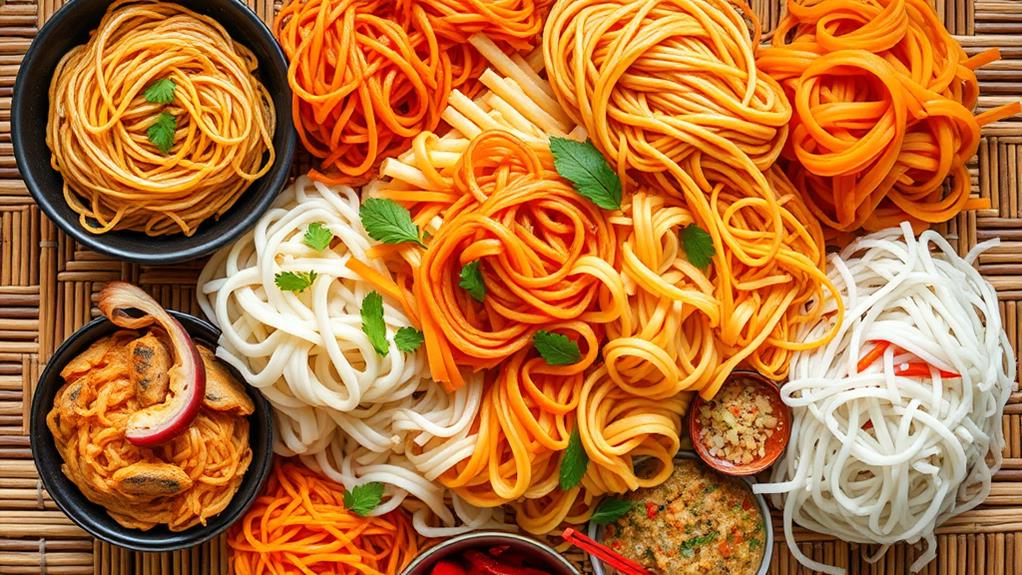
Regional Variations of Pancit Noodle Dishes
The Philippines boasts a diverse range of pancit noodle dishes, each showcasing the country's culinary creativity and regional differences.
Each region has its own unique twist on this popular Filipino dish.
Pancit Malabon is a festive favorite in Malabon City, featuring thick rice noodles topped with a rich shrimp-based sauce and garnished with hard-boiled eggs and green onions.
In contrast, Pancit Hab-hab, also known as Pancit Lucban, is characterized by its unique flat rice noodles served on banana leaves and typically topped with sautéed vegetables and meat. This dish is often enjoyed during local festivals.
Other regional variations include Pancit Lomi, known for its thick, yellow egg noodles served in a savory broth.
Meanwhile, Pancit Batil Patung combines Pansit Miki with minced carabao meat and is topped with a fried egg and crunchy chicharrón, highlighting the area's culinary heritage.
These dishes demonstrate that there is more to pancit than just one recipe, showcasing the country's rich culinary diversity.
Frequently Asked Questions
What Are the Different Types of Pancit?
Pancit is a popular Filipino dish that comes in various regional styles, each with its unique cooking methods, noodle ingredients, and serving traditions.
Regional Varieties: The different types of pancit cater to different tastes, such as Pancit Bihon, which uses thin rice noodles, and Pancit Lomi, which uses thick egg noodles.
Flavor Profiles and Accompaniments: Each type of pancit boasts distinct flavor profiles and accompaniments. For example, Pancit Bihon is often served with vegetables and meat or seafood, while Pancit Lomi is typically served with a savory broth and garnished with vegetables and meat.
Cultural Significance: Pancit has cultural significance in the Philippines, with each region having its own unique way of preparing and serving the dish. Pancit is often served at special occasions and celebrations, such as birthdays and fiestas.
Health Variations: The different types of pancit offer a range of health variations to suit individual preferences. For example, Pancit Bihon is a lower-calorie option, while Pancit Lomi is a heartier, more filling choice.
What Is the Most Popular Pancit?
Pancit Bihon is the most popular pancit. This dish holds a special place in Filipino cuisine, with a rich history and regional variations that showcase different cooking techniques and ingredient substitutions.
Its thin rice noodles and savory flavors make it a crowd-pleaser. Additionally, Pancit Bihon offers numerous health benefits and cultural significance, making it a staple at both festive occasions and everyday meals.
What Is the Difference Between Pancit Bihon and Pancit Guisado?
Pancit Bihon and Pancit Guisado have distinct characteristics.
Pancit Bihon uses thin rice noodles that absorb flavors well, making it a popular choice for celebrations.
In contrast, Pancit Guisado is a stir-fry that combines various noodles and ingredients, making it a quick and easy everyday meal option.
Preparation methods differ between the two dishes.
Pancit Bihon requires soaked noodles, whereas Pancit Guisado can use different noodles without pre-soaking.
These variations reflect regional and traditional takes on this beloved Filipino dish.
What Is the Difference Between Pancit Habhab and Canton?
Pancit Habhab and Pancit Canton are two distinct Filipino noodle dishes with different origins, ingredients, and preparation methods.
Pancit Habhab, which originated in Quezon province, features flat rice noodles served on banana leaves. This dish is often topped with sautéed vegetables and meats, and its simplicity highlights the use of local ingredients.
On the other hand, Pancit Canton is a popular nationwide dish that uses wheat flour noodles. It's typically stir-fried with various meats and seafood, and seasoned with oyster and soy sauces.
While both dishes hold cultural significance, they differ in their cooking techniques, ingredient combinations, and serving traditions.
